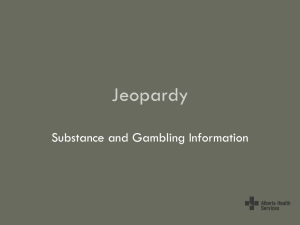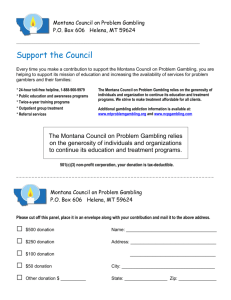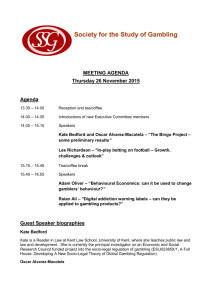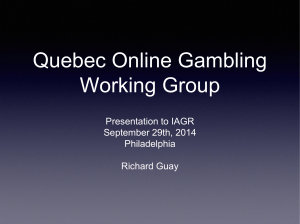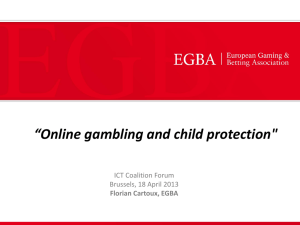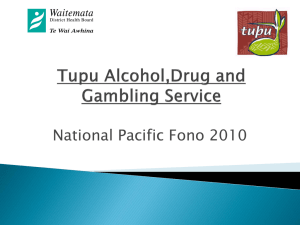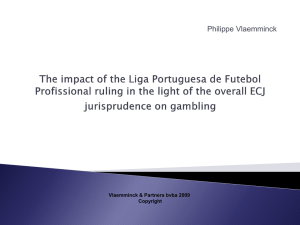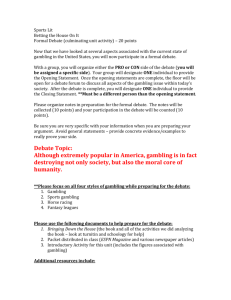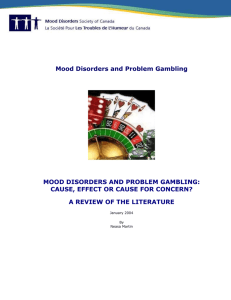Outcome Study - Ministry of Health
advertisement
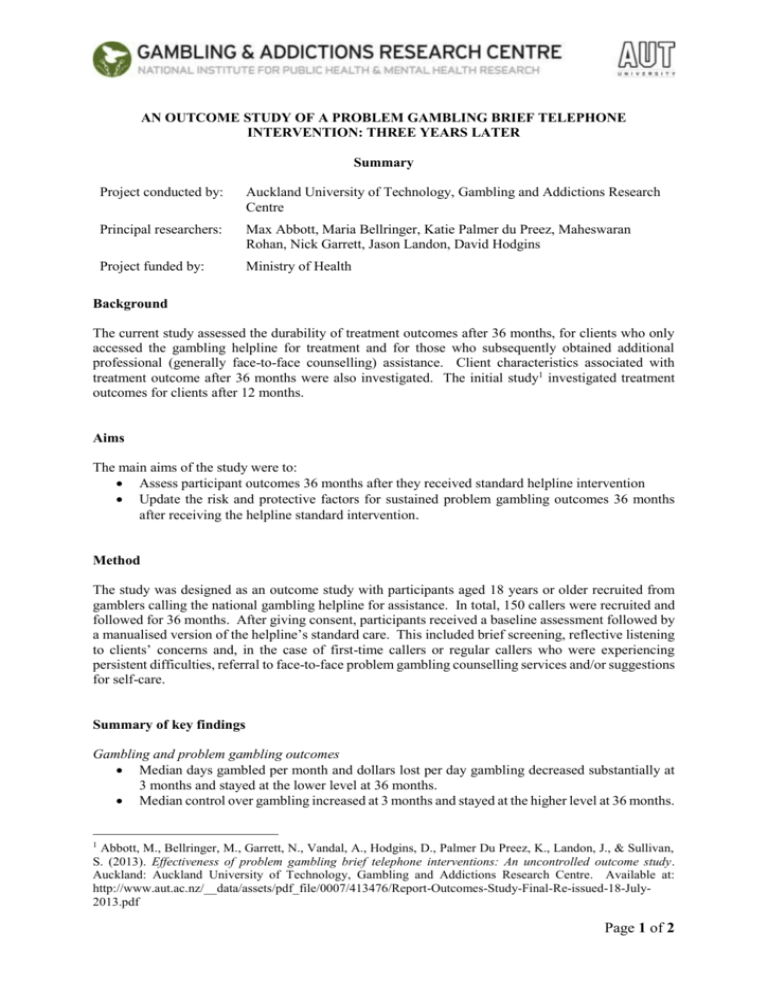
AN OUTCOME STUDY OF A PROBLEM GAMBLING BRIEF TELEPHONE INTERVENTION: THREE YEARS LATER Summary Project conducted by: Auckland University of Technology, Gambling and Addictions Research Centre Principal researchers: Max Abbott, Maria Bellringer, Katie Palmer du Preez, Maheswaran Rohan, Nick Garrett, Jason Landon, David Hodgins Project funded by: Ministry of Health Background The current study assessed the durability of treatment outcomes after 36 months, for clients who only accessed the gambling helpline for treatment and for those who subsequently obtained additional professional (generally face-to-face counselling) assistance. Client characteristics associated with treatment outcome after 36 months were also investigated. The initial study1 investigated treatment outcomes for clients after 12 months. Aims The main aims of the study were to: Assess participant outcomes 36 months after they received standard helpline intervention Update the risk and protective factors for sustained problem gambling outcomes 36 months after receiving the helpline standard intervention. Method The study was designed as an outcome study with participants aged 18 years or older recruited from gamblers calling the national gambling helpline for assistance. In total, 150 callers were recruited and followed for 36 months. After giving consent, participants received a baseline assessment followed by a manualised version of the helpline’s standard care. This included brief screening, reflective listening to clients’ concerns and, in the case of first-time callers or regular callers who were experiencing persistent difficulties, referral to face-to-face problem gambling counselling services and/or suggestions for self-care. Summary of key findings Gambling and problem gambling outcomes Median days gambled per month and dollars lost per day gambling decreased substantially at 3 months and stayed at the lower level at 36 months. Median control over gambling increased at 3 months and stayed at the higher level at 36 months. 1 Abbott, M., Bellringer, M., Garrett, N., Vandal, A., Hodgins, D., Palmer Du Preez, K., Landon, J., & Sullivan, S. (2013). Effectiveness of problem gambling brief telephone interventions: An uncontrolled outcome study. Auckland: Auckland University of Technology, Gambling and Addictions Research Centre. Available at: http://www.aut.ac.nz/__data/assets/pdf_file/0007/413476/Report-Outcomes-Study-Final-Re-issued-18-July2013.pdf Page 1 of 2 Problem gambling severity (past 12 month time frame) median score reduced to 5 at 36 months compared with a baseline score of 17. At baseline 97% were problem gamblers, at 36 months 38% were problem gamblers, 27% were moderate-risk gamblers, 8% were low-risk gamblers and 27% were non-problem gamblers. Other outcomes At baseline, 56% of participants had a high level of psychological distress; this decreased to 3% at 36 months. At baseline, 58% of participants had major depressive disorder; this decreased to 22% at 36 months. The corresponding results for minor depressive disorder were 12% to 0%, and for dysthymia were 42% to 32%. At baseline, 60% of participants smoked tobacco; this decreased to 43% at 36 months. Participants with drug use problems decreased from 23% to 13%. The percentage of people with alcohol abuse/dependence was similar at baseline and 36 months (62%, 64%). Life aspects affected by problem gambling (i.e. work, social and family life, and health) substantially improved at 3 months and showed slight continued improvement at 36 months. Additional assistance At 36 months, 13% of participants reported seeking additional assistance in the past 6 months, both from professional (generally face-to-face counselling) and non-professional (e.g. from a family member, friend or another person) sources. Over the whole study, 36% received additional professional assistance at some time, and 52% received non-professional assistance. Predictors of successful problem gambling outcomes at 36 months Improved outcomes on problem gambling severity were noted for people who were partnered, or who had not previously received treatment for a gambling or mental health problem. Low quality of life and high deprivation were associated with less change in control over gambling. Conclusion The clinically and statistically significant treatment gains found at 12 months were either sustained, or showed further improvement, at 36 months. These changes occurred even though about two-thirds of participants only received one helpline counselling session and did not report accessing other, more intensive, therapy (professional assistance) for their gambling problems throughout the subsequent 36 months. Of note is that the third of participants who received additional professional assistance or support for their gambling problems did not have better outcomes at 36 months than those who did not receive additional treatment. This does not mean that the additional assistance was not of value. People who received it may have been people who, for a variety of reasons, required it. While most participants did well following a single telephone intervention, a minority did not improve and over a third remained in the problem gambling category at 36 months. Page 2 of 2

